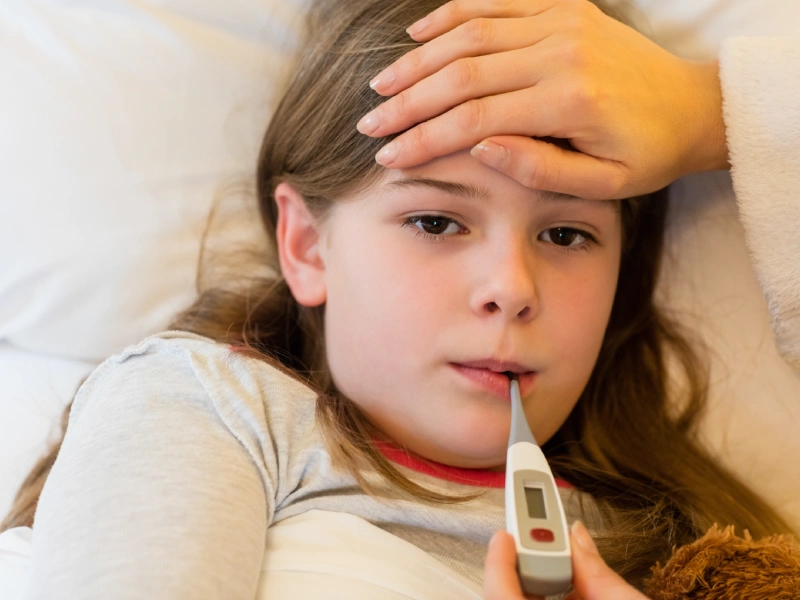High fever is a common but serious medical symptom that indicates the body is fighting an underlying infection or medical condition. At Arete Hospitals, under the guidance of Dr. Ananda Sagari, understanding the symptoms, causes, and effective treatments of high fever is critical to ensuring timely and appropriate medical care. In this article, we provide a comprehensive guide to high fever, addressing its causes, symptoms, diagnostic approaches, and treatment strategies.
Understanding High Fever: Definition and Normal Body Temperature
A normal body temperature typically ranges between 36.1°C (97°F) and 37.2°C (99°F). When body temperature rises above 38°C (100.4°F), it is considered a fever, and temperatures above 39.4°C (103°F) are categorized as high fever. Fever is the body’s natural defense mechanism, stimulating the immune system to combat infections.
High fever can affect all age groups, from children to adults, and can sometimes be life-threatening if not properly addressed. Understanding the underlying cause is crucial in determining the right course of treatment.
Common Symptoms of High Fever
High fever often presents with a variety of physical and systemic symptoms, which may vary depending on the underlying cause. Recognizing these symptoms early can prevent complications:
Elevated body temperature exceeding 38°C (100.4°F)
Chills and shivering as the body attempts to regulate temperature
Sweating following a spike in body temperature
Headache and dizziness due to increased metabolism
Muscle aches and joint pain as a response to inflammation
Fatigue and weakness, often accompanied by loss of appetite
Dehydration, especially in children and elderly patients
Rapid heart rate and breathing in severe cases
In some cases, high fever may be accompanied by seizures in children, known as febrile seizures, which require immediate medical attention.

Primary Causes of High Fever
High fever can result from a wide range of infectious and non-infectious conditions. Some of the most common causes include:
1. Infections
Bacterial infections: Pneumonia, urinary tract infections, meningitis, sepsis
Viral infections: Influenza, dengue fever, COVID-19, measles, chickenpox
Parasitic infections: Malaria, amoebiasis
2. Inflammatory Conditions
Autoimmune disorders such as rheumatoid arthritis, lupus, and inflammatory bowel disease can trigger high fever due to systemic inflammation.
3. Heat-Related Illnesses
Heatstroke and heat exhaustion can cause elevated body temperatures, especially in extreme environmental conditions.
4. Medications and Vaccinations
Certain medications (like antibiotics or chemotherapy drugs) and recent vaccinations can result in a temporary high fever as a side effect.
5. Other Medical Conditions
High fever can also be linked to endocrine disorders, cancers, and metabolic syndromes. A thorough evaluation is essential to identify these less common causes.
When to Seek Immediate Medical Attention
While mild fever may resolve on its own, high fever requires careful monitoring. Immediate medical attention is necessary if:
Fever exceeds 40°C (104°F)
Persistent fever lasts more than 3 days without improvement
Fever is accompanied by difficulty breathing, chest pain, or seizures
Signs of dehydration (dry mouth, decreased urination) are present
Infants under 3 months develop a fever above 38°C (100.4°F)
Diagnostic Approaches for High Fever
At Arete Hospitals, Dr. Ananda Sagari emphasizes accurate diagnosis to identify the root cause of high fever. Common diagnostic procedures include:
Physical examination to assess symptoms and vital signs
Complete blood count (CBC) to detect infections or inflammation
Urine and blood cultures for identifying bacterial pathogens
Imaging studies like X-rays, CT scans, or ultrasounds to detect internal infections
Serology tests for viral infections and autoimmune conditions
Other specialized tests depending on symptoms and patient history
Accurate diagnosis ensures targeted treatment, reducing the risk of complications.
Effective Treatment Options for High Fever
Treatment of high fever focuses on addressing the underlying cause and relieving symptoms.
1. Medications
Antipyretics: Acetaminophen (paracetamol) or ibuprofen to reduce fever
Antibiotics for confirmed bacterial infections
Antivirals in cases of viral infections such as influenza or COVID-19
Hydration therapy using oral rehydration solutions or IV fluids
2. Home Care Measures
Rest to allow the body to recover
Hydration with water, herbal teas, and electrolyte solutions
Light clothing and a comfortable room temperature to prevent overheating
Cool compresses on the forehead, neck, or armpits to alleviate discomfort
3. Hospital Interventions
In severe cases, hospitalization may be required for:
Intravenous antibiotics or antivirals
Oxygen therapy for respiratory distress
Monitoring and management of complications such as sepsis or organ dysfunction
Preventive Measures for High Fever
Preventing high fever involves reducing exposure to infections and maintaining overall health:
Vaccinations against common infectious diseases
Proper hand hygiene and sanitation practices
Avoiding contact with sick individuals
Maintaining a balanced diet and hydration
Managing chronic medical conditions to reduce susceptibility
High Fever in Special Populations
Children
Children are more prone to febrile illnesses, and their fevers can rise rapidly. Parental vigilance and timely medical intervention are crucial.
Elderly Adults
High fever in older adults may be subtle but can indicate serious infections or systemic illnesses. Early detection is essential to prevent complications.
Immunocompromised Patients
Individuals with weakened immune systems, such as cancer patients or transplant recipients, are at higher risk for severe infections and require close monitoring for fever.
Conclusion
High fever is more than just an uncomfortable symptom; it is a significant health concern that requires careful evaluation, timely treatment, and preventive strategies. Under the expert care of Dr. Ananda Sagari at Arete Hospitals, patients benefit from comprehensive diagnostics, targeted treatments, and personalized care plans. Recognizing the symptoms, understanding the causes, and applying effective treatments ensures that high fever is managed safely and efficiently, reducing the risk of complications and promoting faster recovery.